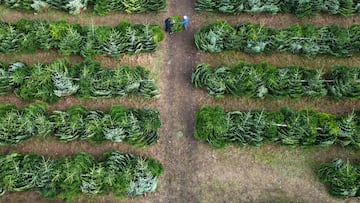Real vs. Artificial: Which Christmas tree is greener?
Over 90 million households will display a Christmas tree this year. Here, we compare the environmental impact of artificial versus real Christmas trees.


According to the American Christmas Tree Association, the vast majority of households, around 84 percent, display artificial trees during the holiday season. For those accustomed to a natural tree, making the jump to artificial trees can feel like missing out on a key feature of the holiday. However, as artificial trees have become easier to store, they have become attractive since they don’t release needles and always look fresh.
Get in the holiday spirit with the perfect soundtrack for decorating your Christmas tree this season! 🎶🎅 Our Spotify profile has everything you need, from cozy classics to upbeat festive hits! pic.twitter.com/P8D1TjeAUK
— American Christmas Tree Association (@americantrees) November 22, 2024
Additionally, those in the artificial tree market tout the environmental benefits of their product. However, as most of these trees are made of plastic, there are questions about the ecological impact of their production. Most artificial trees come from China, and the environmental organization The Nature Conservancy (TNC) notes that the emissions from transporting these products to the U.S. must be factored into their carbon footprint. These questions are further complicated because Christmas tree farms are businesses that plant trees specifically to cut them down, making their environmental impacts cyclical. Older trees are cut down, and new seedlings are planted each year. The Nature Conservancy argues that real trees are greener because they do not require emissions to produce. Although they lead to deforestation, the business model ensures more trees are planted and trees remain standing until they are cut. This allows them to serve as a carbon sink until they are harvested and replaced by another generation.
Natural or artificial trees, which are better? Supporting local, sustainable forests, and farms wins this one. Learn more https://t.co/qe4nJB0iBW. #SustainabilitySunday pic.twitter.com/m6AKC4XP0F
— City of Beaverton (@CityofBeaverton) December 3, 2023
What the science says
While there is some release of carbon from the decomposition of a real Christmas tree, it does not compare to the environmental impact of creating an artificial one. Science Focus examined this comparison and found that an artificial tree will release around 40 kilograms of carbon dioxide, while a real tree that ends up in a wood chipper or bonfire has a carbon footprint of just 3.5 kilograms of carbon dioxide. If it ends up in a landfill, the CO2 calculation increases to 16 kilograms, but it is still far less than that of an artificial tree.
Related stories
Scientists who examined the difference state that for an artificial tree to offset its carbon footprint, the household would need to reuse the tree for at least 12 years to make it greener than a real tree that is burned.
Get your game on! Whether you’re into NFL touchdowns, NBA buzzer-beaters, world-class soccer goals, or MLB home runs, our app has it all. Dive into live coverage, expert insights, breaking news, exclusive videos, and more – plus, stay updated on the latest in current affairs and entertainment. Download now for all-access coverage, right at your fingertips – anytime, anywhere.
Complete your personal details to comment